By Andrea Byrnes. Published on Egyptological, September 9th 2011, Magazine Edition 2
Introduction
One of the many fabulous items in the jewellery collection from the tomb of Tutankhamen is a breast ornament [Figure 1]. A highly decorative piece in the form of a winged scarab, dating to around 1330 BCE, it is currently on display in the Egyptian Museum in Cairo (JE 61884; Burton Photo No. P1133; Carter No. 267d). Adorned with silver, semi-precious stones and glass paste, all set into gold, the eye-catching centrepiece is a semi-translucent green scarab. Remarkable for its beauty, the pectoral has the added interest of scientific and archaeological mysteries that have yet to be completely unraveled. It has only been recognized recently that the green scarab [Figure 2] is made of a stone called Libyan Desert Glass, which can be sourced only in a small area of the deep desert untouched by Pharaonic exploration, 100s of kilometres away from the nearest source of water.
The Pectoral
The sophistication and complexity of the iconography and the skill with which the item was made, together with the quality of the materials used, indicate that this was an important piece. At its heart, the focal point of the entire composition was the green scarab.
Howard Carter’s catalogue notes, available from the Griffiths Institute Archive, listed it as follows:
Carter No.: 267d
Handlist description: Lunar and solar breast ornament
Card/Transcription No.: 267d-1
267, D. LUNAR AND SOLAR BREAST ORNAMENT.
Max. H. 14.9, Max. W. 14.5, cms.
An open-work breast ornament of complex design:A combined Kheper-and-solar-hawk supporting the lunar barque containing the “eye of Horus” (i.e. the moon), surmounted by the crescent (gold) and lunar orb (silver) upon which are applied (in gold) a figure of the King between the two gods Herakhty (of the eastern horizon) and Aah (Thoth, the moon god).
In the lunar barque are two solar uraei; pendant on either side of the Kheper-and-solar-hawk a solar uraeus; in the talons of the Kheper-and-solar-hawk Shen symbols and lotus lilies; and depending from the lower bar of contiguous circles are lotus flowers, poppies, complex buds and papyrus corollae, between concentric circles (attached to the stems of the lotus flowers.)
On the ends of the hawk’s wings are six eyelets (on either side) for attachment, apparently by which the ornament pended.
For materials employed see note A. L.Carter No.: 267d
Handlist description: Lunar and solar breast ornament
Card/Transcription No.: 267d-2
267, D. PECTORAL
MATERIALS OF WHICH COMPOSED
(1) Gold Quality fair, much tarnished.
(2) Silver For lunar disc. This was covered with a thick black deposit of sulphide of silver.
(3) Natural stones Chalcedony (semi translucent yellow). Carnelian Lapis lazuli Calcite Obsidian? (for pupil of eye) Turquoise
(4) Glass Red, blue, green, black and white.
TREATMENT: Cleaned with warm water, and potassium cyanide.
Note: In two cases a blue bead was attached by thread to top of small pendant thus, <>
A. L.
As Carter noted, the pectoral takes the form of a falcon or vulture with a kheper scarab at its heart. The body and head of the scarab are surrounded by the wings, tail, legs and claws of a bird of prey. The scarab was a symbol of the solar cycle, representing the form of the sun god which rose over the eastern horizon. The bird of prey was probably either a vulture (Nekhebet) or a falcon. The vulture, a protective deity usually associated with Lower Egypt was closely linked with the king. There are a number of falcon deities but the most likely candidate is either Horus, a sky deity who had a close association with the moon or Ra, the sun god. In the composition the scarab supports a celestial barque in which the left eye of Horus, symbol of the moon, holds up a horizontal crescent moon with silver moon-disk resting within it. Applied to the silver disk are gold images of the Pharaoh with the moon above his head, accompanied by moon deity Thoth (Djehuty) in the form of an ibis-headed man and the deity of the morning sunrise Re-Horakhty, Ra of the Horizons. The moon is flanked, within the celestial barque, by two cobras crowned with gold solar disks. The cobra, Wadjet, often shown in tandem with the vulture, was identified with Lower Egypt and, like Nekhebet, is closely associated with the role and identity of the king. In the claws of the falcon-scarab are two shen symbols of eternity. To the left and right of the claws are the symbols of Upper Egypt, the lily and lotus. Flanking these are two more cobras, each with yellowish solar disks on their heads. Beneath the tail are lotus and papyrus emblems, symbols of Upper and Lower Egypt. The iconography of the entire piece deals with solar and lunar cycles, resurrection, kingship and the enduring kingship and identity of Egypt.
Materials used in its fabrication were gold, silver, lapis lazuli, carnelian, turquoise, and coloured glass, all admired and highly valued during the New Kingdom. Glass-making reached a peak in the Eighteenth Dynasty, following the reign of Tuthmosis III, when glass paste became a major feature of decorated precious items deposited in the tomb of Tutankhamen, including the famous death mask. Silver, less common than gold in Ancient Egypt, was very highly valued. Semi-precious stones do not seem to have had a lesser value than those that are today classified as precious stones. Glass, which was probably introduced from Mesopotamia, was new, colourful, flexible, and vibrant.
The quality of the pectoral and the sophistication of the iconography and craftsmanship, together with the materials used in its fabrication, indicate the value and status of the item. The use of the green material at the heart of the scarab suggests that the translucent substance was valued a source of considerable cachet and prestige.
Libyan Desert Glass
When Howard Carter found the pectoral in 1922 he assumed that the glass-like substance carved in the form of a large scarab was chalcedony, a translucent quartz. In most books on the subject, including modern guides to the Egyptian Museum in Cairo, where the pectoral is on display, it is still listed as chalcedony. In 1999, however, Italian mineralogist Vincenzo de Michele, explorer Giancarlo Negro and geologist Aly Barakat identified it as Libyan Desert Glass, using non-invasive optical measurements.
Libyan Desert Glass (LDG), also known as silica glass, is found in an area roughly 60km by 100km in the far southwest Egyptian Desert in the southern reaches of the Great Sand Sea, which lies to the northeast of the vast Gilf Kebir plateau. The earliest identification of the glass was made by Patrick Clayton in 1932, in his role as Inspector of Desert Surveys for the Survey of Egypt, 10 years after Carter’s discovery of Tutankhamen. Clayton and the Keeper of Minerals at the British Museum, L.J. Spencer published an article about the glass in 1933, concluding that the substance was 97.58% silica. Libyan Desert Glass is an even purer form of glass than volcanic obsidian, which has only a 75% silica content. The character of Libyan Desert Glass is very variable. The finest pieces, such as that selected for the scarab in Tutankhamen’s pectoral, are dark green, smooth-surfaced, translucent and contain no inclusions or blemishes [Figure 3]. At the other extreme arelight, milky pieces which are almost completely opaque, sometimes with pitted surfaces and air bubbles inside. Between the two extremes are a variety of shades and degrees of opacity between green and yellow, some with white specks and others with brown streaks [Figure 4]. Most pieces are around an inch in length but the largest ever found was 57lbs in weight. Libyan Desert Glass has been fission-track dated to nearly 29 million years old.
Theories about the formation of Libyan Desert Glass have divided researchers. In the 1930s an overview of the surrounding geology by Clayton and Spencer (1933) failed to provide an explanation as to how it was formed. They pointed to some similarities to tektites, glass rocks formed when meteorites collide with the Earth, forming as a result of heat and shock. The presence of meteorite craters in southwest Egypt certainly hinted that this was a plausible idea, but Clayton and Spencer noted that the sheer volume of the Libyan Desert Glass far exceeded tektites from other parts of the planet, that they differed in colour and transparency and that the nearest impact crater was 200 miles to the south.
Another school of thought looked to organic inclusions in the glass for a solution that did not require a meteoric explanation. This theory, proposed by geologist Ulrich Jux, sees water trickling through hot underground channels at the base of a volcanic lake, dissolving silica from the rocks through which it travelled, finally collecting to form silica-rich Libyan Desert Glass. This was undermined by the dating of the lakes to 9000 years old, whereas the glass itself is millions of years older.
Astrochemist Christian Koeberl established that Libyan Desert Glass had been formed at temperatures so hot that a meteorite explosion was the most logical explanation. Edmond Diemer concluded that the silica could not have formed under temperatures less than 1676 degrees centigrade and pointed to the presence of a quartz crystal called stishovite, a particularly hard form of silicon dioxide that is only formed by a shock of over 200,000 bars (Diemer 2000). Diemer sees the presence of iridium and other metals in the glass as closely resembling materials in meteorites, but like Clayton and Spencer before him he was unable to identify a suitable meteorite crater. Another problem was that unlike other desert glass created at impact craters, LDG was too pure and unblemished by any melding with fragments from the meteorite or the meteorite crater.
The recent discovery of a crater on satellite photographs by Farouk El-Baz, named the Kebira crater, raised the possibility that a solution had been found, but a survey by Di Martino and his team in 1996 failed to reveal any signs that this was an impact crater and, although unusually vast, may be one of the area’s many volcanic craters instead [Figure 5].
Christian Koeberl believes that a meteorite collision was, in fact, responsible. Instead of a straightforward impact, he suggests that a meteorite could have entered the Earth’s atmosphere at a shallow angle and, when it reached the surface of the planet, skimmed across the desert sand, creating immense heat as it progressed.
The 1908 flattening of 80 million trees in Tunguska in Siberia provided a possible explanation to the absence of a meteor crater. It is thought that something exploded above Tunguska rather than impacting with the planet and creating a crater. Geophysicist John Wasson and Kelly Moore suggested that the Tunguska case might explain the creation of the glass (1998).
In 1994 a massive fireball was created when the comet Shoemaker-Levy 9 collided with the planet Jupiter. The data from the collision was used by Physicist Mark Boslough and colleagues from the Sandia National Laboratories to model a similar explosion on Earth. The simulation indicated that a fireball, exploding a few kilometres above the surface of the Earth, could generate temperatures of up to 1,800 degrees centigrade, with an estimated speed of air behind the blast wave of several 100 metres per second and could leave a field of glass in its wake. This theory is also supported by other researchers. At the moment this is probably the most plausible explanation for how Libyan Desert Glass was created, but it has not gone unchallenged, most notably by Koeberl’s skimming meteorite theory.
How did the glass reach the Nile?
The ongoing mysteries of the pectoral are 1) how the Libyan Desert Glass reached the Nile and 2) why the glass was so highly valued.
Unlike the Eastern Desert, the Western Desert had few advantages for the Egyptians. Lacking the stone and mineral resources which were so richly exploited in the Eastern Desert, the endless sands of the Western Desert, interrupted only by a crescent of oases, made up a harsh and barren environment that was of no practical use for resource exploitation. The only experience that the Egyptians had of the Western Desert was for travel, with a land route to the south and various river bypasses.
There were many routes that passed through the Western Desert in the New Kingdom. One linked Memphis with the Oases, Wawat (northern Nubia) and Kush (southern Nubia), with connections to the Egyptian Nile at Abydos, Quseir and Elephantine. These were largely used for trade with Nubia and for supply to the oases, which were the last outpost of Egypt’s authority in the west and Egypt’s fortresses in Nubia. Others crossed the Qena curve. None of these routes, however, approached the Libyan borders where the Libyan Desert Glass was found.
The next obvious place to look is the Abu Ballas Trail. The small Abu Ballas sandstone hillock was the site of a pottery dump discovered by geologist John Ball in 1918. The pottery was later dated to periods from the Old Kingdom or First Intermediate to the Roman period [Figure 7]. The Trail, of which Abu Ballas is one staging post, was identified by Carlo Bergmann in the late 1990s. It consists of nearly 400km of up to 30 staging posts from Ain Asil in Dakhleh Oasis towards the Gilf Kebir, all with pottery from various Pharaonic periods. It is unknown exactly why the trail was formed or what it was used for. Possible explanations are: exploration, mineral prospecting or prevention of smuggling and incursions by the neighbouring Libyans. Although the Abu Ballas trail is far nearer to the Libyan Desert Glass fields than the known trade and supply routes, the trail heads southwest from Dakhleh whereas the silica glass fields are almost due west. Whilst it is possible that other exploration routes led to the Libyan Desert Glass fields, it seems unlikely that only one piece of the Libyan Desert Glass would have been retrieved in any serious investigation of the area.
An alternative explanation may lie further to the west. Libya posed an ongoing threat to Egypt. A number of different groups appear to have occupied Libya, including the Ribu (Graeco-Roman Libu), Meshwesh, Tjehenu and Tjemehu. In the reign of Sahure there are records of the surrender of a Libyan group. In the Middle Kingdom King Merenptah prevented invasions of the Meshwesh and Ribu. By the Nineteenth Dynasty Libyans were firmly established as enemies of the state, represented as prisoners on the walls of Ramesside mortuary temples. Most of these disputes, however, took place in the north, along the Mediterranean coast into the western Delta. Roe states that there is “some evidence that Tjemehu peoples of the second millennium BCE were pastoral nomads or possible semi-nomads” (Roe 2008). Nomads leave very little archaeological evidence, but the available data suggests that they were cattle herders. Nomadic groups can survive in surprisingly harsh conditions. Although the Toubou camel and goat herders of north Chad’s Tibesti highlands left the southwest Egyptian desert region early in the 20th Century, they managed to eke out a seasonal existence until then in the plateau and hilly areas of the Gilf Kebir and Gebel Uweinat, where storm rainfall was sufficient to provide vegetation. There is evidence, quoted by Roe, suggesting that nomadic bands reached Bahariya and possibly Farafra. Anthony Mills suggests that the incursions were probably the result of drought in the desert, mainly in the north to the Western Delta and south to Dakhleh Oasis (Mills 2007, 2010). As well as subsistence, the reasons for these incursions could also have included raids on property or small scale military forays. It is possible that the Libyan Desert Glass used to create the centrepiece of Tutankhamen’s pectoral was introduced not by Egyptian explorers and prospectors but by Libyan nomads en route to Dakhleh Oasis.
Ultimately, the question of how the Libyan Glass arrived in the Nile valley remains unanswered.
The future of Libyan Desert Glass
Unfortunately, Libyan Desert Glass is a finite resource. Formed 29 million years ago, it is fast becoming scarce. Writing in 1982, and quoted by Rudolph Kuper in 2002, Western Desert explorer and founder of the Long Range Desert Group Ralph Bagnold wrote that for the sake of posterity “it is to be hoped (I fear probably in vain) that mankind’s craving for exploitation will not lead to the exhaustion of the accumulated past.” His concerns were prescient, as more and more of the natural and archaeological legacy of the Western Desert is being damaged or removed forever [Figure 8]. Unexpectedly fashionable, Libyan Desert Glass has become a very desirable item for purchase. Tourism, for once, is not the biggest cause of the problem, although it is a significant contributor. The main cause of the denudation of the glass fields is systematic collection by local merchants who sell it in the Red Sea resorts and to traders who sell it online, either in its raw state or formed into items of jewellery.
Conclusion
Building upon skills developed in the Middle Kingdom, New Kingdom art and craft produced some remarkable pieces of jewellery. Semi precious stones were valued for their translucent quality and their intense colours, and glass paste was manufactured to remarkably high standards in a variety of colours to achieve bright, light effects. Set within gold, the rich colours were perfectly displayed. Such items remain a significant influence on modern designers.
The Libyan Desert Glass scarab in the centre of Tutankhamen’s breast ornament met a number of criteria that appealed to the Egyptians. It was translucent, richly coloured and could be precisely carved and shaped. It was also apparently, at that time, unique. No other examples of it have been found in Ancient Egyptian jewellery.
Although there are a number of plausible theories about how the Libyan Desert Glass was formed 29 million years ago, it remains a mystery how the piece in Tutankhamen’s breast ornament found its way from the deep desert into the hands of the Royal craftsmen and the Pharaoh’s tomb in the Valley of the Kings.
Photograph Credits
Images 1 and 2, Tutankhamun Pectoral, by Jon Bodsworth, with permission, cropped by Andrea Byrnes
Image 3, Libyan Desert Glass, by H. Raab 2006 (under Creative Commons License)
Image 4, Libyan Desert Glass by Claire H. (under Creative Commons License), cropped by Andrea Byrnes.
Image 5, by NASA, Landsat 7 image acquired using bands 3, 2, and 1 on March 21, 2003.
Image 6, Libyan Desert Glass in situ by Helen Romberg, with my thanks for the permission to use the photograph. See original at: http://www.flickr.com/photos/helenromberg/1017997918/#/
Image 7, Abu Ballas pottery, by Andrea Byrnes
Image 8, Depleted Libyan Desert Glass Field, by Andrea Byrnes
References
All website links were checked and were active at the time of publication.
Barnes, V.E. and Underwood Jr., J.R., New investigations of the strewn field of Libyan desert glass and its petrography. Earth and Planetary Science Letters, Volume 30, Issue 1, April 1976, Pages 117-122
Bergmann, C. 2003, Discovery of the Abu Ballas Trail
www.carlo-bergmann.de/Discoveries/discovery.htm
Bongioanni, A. and Croce, M.S. (eds) 2003, The Treasures of Ancient Egypt: The Collection of the Egyptian Museum in Cairo. White Star
Boslough, M. 2006/2007, Solving the riddle of the desert glass. Sandia Technology Magazine, Sandia National Laboratories, Winter 2006/2007
http://www.sandia.gov/news/publications/technology/2006/0804/glass.html
Carter No.: 267d, Handlist description: Lunar and solar breast ornament, Card/Transcription No.: 267d-1. Griffith Institute
http://www.griffith.ox.ac.uk/gri/carter/267d-c267d-1.html
Carter No.: 267d, Handlist description: Lunar and solar breast ornament. Card/Transcription No.: 267d-2. Griffith Institute
http://www.griffith.ox.ac.uk/gri/carter/267d-c267d-2.html
Clayton, P.A. and Spencer, L.J. 1933, Silica-glass from the Libyan Desert. Mineral Magazine 23, p.501-508.
De Michele, V. (ed.), Proceedings of the Silica ’96 Meeting on Libyan Desert Glass and Related Desert Events, Bologna University 1997
Diemer, E. 2000, Libyan glass: An impactite? In De Flers, P and P., 2000. Egypt: Civilization in the Sands. p.197 Konemann
Di Martino, M., Orti, L., Matassoni, L., Morelli, M., Serra, R., and Buzzigoli, A. 2006, Non-Impact Origin of the crater Field in the Gilf Kebir Region (SW Egypt). 40th ESLAB First International Conference on Impact Cratering in the Solar System, Monday 8 May 2006
http://sci.esa.int/science-e/www/object/index.cfm?fobjectid=39029&fbodylongid=1924
http://sci.esa.int/science-e/www/object/doc.cfm?fobjectid=40214
Howard, K.T. 2011, Volatile enhanced dispersal of high velocity impact melts and the origin of tektites, Proceedings of the Geologists’ Association 12 (2011) 363-382
Jux, U. (1983): Zusammensetzung und Ursprung von Wüstengläsern aus der Großen Sandsee Ägyptens. Zeitschrift der Deutschen
Keenan, J. 2002, Tourism, Development and Conservation: A Saharan Perspective. Natural resources and cultural heritage of the Libyan Desert: Proceedings of a conference held in Libya. 14-21 December 2002, Society for Libyan Studies
Koeberl, C. (1997), Libyan Desert Glass: Geochemical composition and origin. In Proceedings of the Silica ’96 Meeting on Libyan Desert Glass and related desert events, Bologna (Ed. V. de Michele), Pyramids, Segrate (Milano), p. 121-131.
www.univie.ac.at/geochemistry/koeberl/publikation_list/132-Libyan-Desert-Glass-Proc-Bologna-Mtg-1997.pdf
Koeberl, C., Reimold, W.U., and Plescia, J. (2005) BP and Oasis impact structures, Libya: Remote sensing and field studies. In: (eds. Koeberl, C., and Henkel, H.), Impact Tectonics. Impact Studies, vol. 6, Springer, Heidelberg, pp. 161-190.
www.univie.ac.at/geochemistry/koeberl/publikation_list/264-BP%20Oasis-Impact%20Tectonics-2005.pdf
Kuper, R. 2002, Routes and roots in Egypt’s Western Desert. The Early Holocene resettlement of the Eastern Sahara. In Friedman, R. (ed.) 2002, Egypt and Nubia. Gifts of the Desert, The British Museum Press, p.1-12
Matsubara, K., Matsuda, J.I., and Koeberl, C. (1991), Noble gases and K-Ar ages in Aouelloul, Zhamanshin, and Libyan Desert impact glasses. Geochimica et Cosmochimica Acta 55, p.2951-2955
www.univie.ac.at/geochemistry/koeberl/publikation_list/057-Noble-gases-tektites-GCA-1991.pdf
Mills, A.J. 2007, 2010, The Oases. In Wilkinson (ed) 2007, 2010, The Egyptian World, Routledge
Nicholson, P.T. and Henderson, J. 2000, Glass. In ed. Nicholson, P.T. and Shaw, I., Ancient Egyptian Materials and Technology, Cambridge University Press, p.195-224
Olsen J.W. and Underwood, J.R. 1979, Desert Glass: An Enigma. Saudi Aramco World September/October 1979, Volume 30, Number 5
http://www.saudiaramcoworld.com/issue/197905/desert.glass-an.enigma.htm
Schneider, T. 2010, Foreigners in Egypt: Archaeological evidence and cultural context. In Wendrich, W. (ed.), Egyptian Archaeology, Wiley-Blackwell, p.143-163
Seebaugh, W.R., Kinser, D.L., Hoff, R. and Weeks, R.A., 1985, Cooling and Crystallization Rates of Libyan Desert Glass, Journal of Non-Crystalline Solids, Volume 1, Issue 1-3, May 1985, p.387-395
Seebaugh W. R. and Strauss A. M. (1984), A cometary impact model for the source of Libyan Desert Glass. Journal of Non-Crystalline Solids, 67, 51 l-519.
Wasson, J.T. and Moore, K. 1998, Possible Formation of Libyan Desert Glass by a Tunguska-like Aerial Burst. 61st Annual Meteoritical Society Meeting, July 1998
http://www.lpi.usra.edu/meetings/metsoc98/pdf/5303.pdf
Weeks, R.A., Underwood, J.R. and Giegengack, R. 1984, Libyan Desert Glass: A Review. Journal of Non-Crystalline Solids 67, p.593-619
Wilkinson, R.H. 2003, The Complete Gods and Goddesses of Ancient Egypt. Thames and Hudson.
Wright, G. 1999, The riddle of the sands, New Scientist, 10th July 1999, Issue 2194
Further Reading
All website links were checked and were active at the time of publication.
Horizon: Tutunkhamun’s Fireball, made by production company TV6, (broadcast on BBC Two on Thursday, 20 July)
http://www.tv6.co.uk/Productions/Science/39-/The-Fireball-of-Tutankhamen (with video)
Tut’s gem hints at space impact
BBC News 19 July 2006
http://news.bbc.co.uk/1/hi/5196362.stm
Largest Crater in the Sahara Discovered by Boston University Scientists
Boston University News Release, March 3, 2006
http://www.bu.edu/phpbin/news/releases/display.php?id=1073
High-Performance Computing Provides Clues to Scientific Mystery
Sandia National Laboratories, 2007 Annual Report
http://www.sandia.gov/news/publications/annual/2007/ste4.html
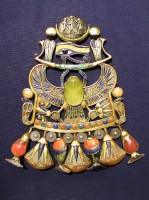

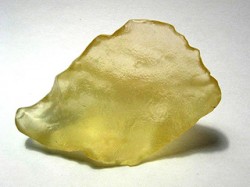
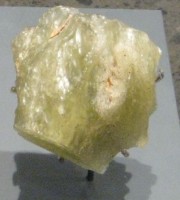
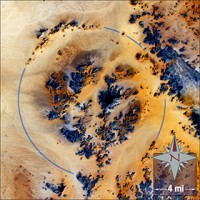
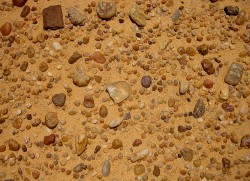
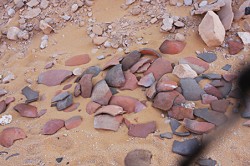
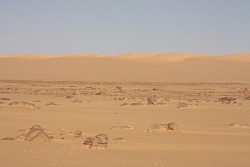
 By
By